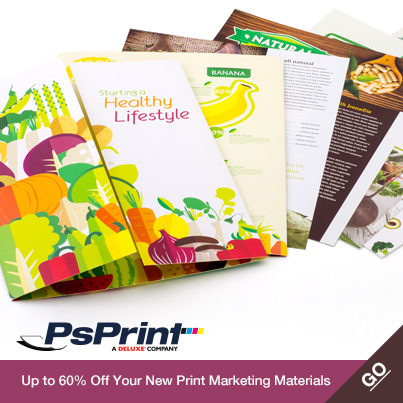Add an extra special touch to your print marketing tools by adding print finish to your products. Embossing and debossing enhance visual interest, add appealing textures and suggest brand value. Print compelling marketing materials that command attention and influence customer perceptions with these finishing options.
The lowdown on embossing and debossing
Both effects are created with dies, or metal plates, that stamp the paper. Embossing is when a graphic is raised above the surface of the paper. With embossing the design is stamped from the back to create a raised graphic on the front. Debossing is when a graphic is depressed into the paper. With debossing, the design is indented from the front. The result is a 3D effect that’s perfect for highlighting logos, images, and text, or for adding patterned textures to paper.
You can enhance a deboss or emboss with additional finishing options such as colored ink and foil stamps (this is also known as a combination or registered embossing and debossing); or, you can simply leave them as is.
Thick, heavy paper stocks are best for embossing and debossing. They make it easier for your designs to stand out, especially if you have multi-level designs with varying depth. Thicker paper also prevents the design from sticking out the back.

The same logo, embossed on the left and debossed on the right. Artwork courtesy Alfred Tam.
Emboss or deboss to influence perception
Unique visuals coupled with a pleasant tactile experience mean potential customers will view your brand, products, and services as high-quality and desirable.
Those attributes make embossing and debossing fantastic finishing options for business cards, invitations, greeting cards, letterhead, envelopes, presentation folders and other printed collateral you use for sales, marketing and networking.
Product embossing ideas
- A business card logo, finished with a colorful foil stamp
- The images on a greeting card
- The text and illustrations on the front of a pocket folder
Product debossing ideas
- A bold sales letter headline, filled with a bright, attention-getting ink
- The bride and groom names on wedding invitations

Embossed invitation. Artwork courtesy Tamara Sandakly.
How to add an emboss or deboss to your design
The best place to start is with your printing company. Reach out to your printer’s customer service team to find out what you need to do to ensure your emboss or deboss is applied exactly as you envision.
Your printing company might send you a special template for your design, along with instructions for file setup (for example, they may prefer vector artwork). Once you’ve created your design according to their specs, your printing company will transfer the design to plates so they can apply your emboss or deboss.
There’s really no limit to how you can use embossing and debossing — get creative, and brainstorm unique ways to incorporate these techniques to print marketing tools that impress prospects. And when you're ready to make your print marketing pop, contact PsPrint to get started. Take advantage of premium printing at discount prices!










No comments yet.